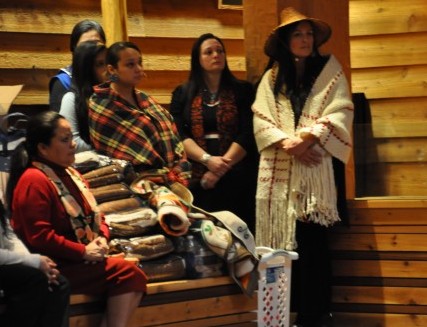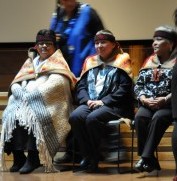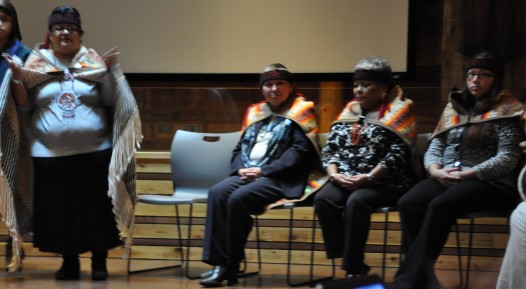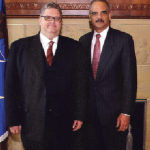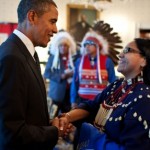
Indian Country Today Media Network Staff
In one of her columns for Indian Country Today, Suzan Shown Harjo wrote: “Only the reinstatement of tribal jurisdiction and remedies has a chance of reversing the epidemic levels of violence against Native women.” That commentary was published April 29, 2005.
Today, after years of struggle, tribal advocates are celebrating Congress passing the VAWA reauthorization, with tribal provisions. The act is now heading to President Obama for his signature.
Harjo, Cheyenne and & Hodulgee Muscogee, is an award-winning columnist and a poet, writer, curator and policy advocate, who has helped Native Peoples to protect sacred places and recover more than one million acres of land, is president of the Morning Star Institute in Washington, D.C. She’s also still regularly contributing to this publication.
The spotlight on the VAWA reauthorization, with tribal provisions, was magnified by Harjo’s 2005 ICT column, and it roused both regional and national mainstream media from their collective slumber concerning this crucial matter. There is something to the old saying “the pen is mightier than the sword.”
In light of the recent action on VAWA, and the impending action by Obama, it seems like an ideal time to revisit Harjo’s column, titled “Congress Make the Streets Safe for Indian Women, too.” Here is that work, in full.
Congress, Make the Streets Safe for Indian Women, Too, April 29, 2005
The streets of Indian country aren’t safe for American Indian and Alaska Native women.
Nearly 90 percent of the perpetrators of violent crimes against Native women are non-Indians—60 percent are white men—and Native nations can’t touch them.
Congress created this haven for non-Indian criminals on reservations and it’s up to Congress to fix it. The 109th Congress has a chance to do that very thing this year, when it considers reauthorizing the Violence Against Women Act.
VAWA 2005 is being drafted now to address the deplorable situation of women in American, where physical abuse is a feature of one-quarter of all marriages and where one-third of women who are treated in emergency rooms are victims of domestic violence.
While Native women also sustain injuries in abusive relationships, most of the men who assault Native women are strangers or acquaintances (80 percent), rather than intimate partners or family members (20 percent), according to a U.S. Bureau of Justice Statistics report, American Indians and Crime (1992-2002), issued in December 2004.
This statistical profile and a raft of other studies, including the 2000 National Violence Against Women Survey, report that:
● American Indian and Alaska Native women are more than twice as likely to be victims of violent crime than other women in America.
● American Indian and Alaska Native women suffer sexual assaults at a rate of more than three times that of women of other races.
● more than one in three American Indian and Alaska Native women will be raped during her lifetime.
● the rate of violent crime experienced by American Indian women is nearly 50 percent higher than that reported by black males, the second highest gender/race category victimized by violent crime.
Most violent crimes are committed intra-racially, as with white-on-white crime. This is not the pattern in Indian country, where 88 percent of the perpetrators of violent crime against Indians are non-Indians.
Why can’t Indian governments punish these violent non-Indians and why should Congress step in? It’s a long, complex history, but the short answer is that the federal government made this jurisdictional mess and should take every opportunity to clean it up.
Over a century ago in the name of “Indian civilization,” the federal government criminalized tribal traditions and took control of the reservations. When the Supreme Court ruled that the federal government did not have jurisdiction over Indian murders of Indians, Congress enacted the Major Crimes Act, authorizing federal jurisdiction over murder and other serious offenses involving Indian people.
Congress expanded federal jurisdiction, effectively restricting tribal authorities, under the Assimilative Crimes Act and myriad gaming, environmental, repatriation, arts and other laws.
Tribal jurisdiction and remedies were limited under the federal tribal termination policy. Starting in the 1940s, Congress gave selected states certain criminal and civil authorities over Indian offenses. In the 1968 Indian Civil Rights Act, Congress restricted the sentencing authority of tribal courts to one-year imprisonment and a $5,000 fine. The Supreme Court ruled in 1978 that Indian tribes cannot prosecute non-Indians in criminal matters.
That brings us to the present situation where Native nations cannot punish non-Indians who harm Indian women in Indian territory, or can only give them a slap on the wrist.
There are many reasons that the federal and state governments aren’t doing a better job at bringing these bad men to justice. Basically, it comes down to geography and connectedness. The federal and state agents don’t live where the crimes are being committed and the victims aren’t their neighbors.
Only the reinstatement of tribal jurisdiction and remedies has a chance of reversing the epidemic levels of violence against Native women.
In VAWA 2005, Congress can address the jurisdictional void that prevents Indian tribes from prosecuting non-Indians perpetrating these crimes.
VAWA was signed into law in 1994 and reauthorized in 2000. VAWA 2000 mandates that protection orders from one tribe or state be afforded full faith and credit in outside jurisdictions. It also clarifies that Indian tribes have full civil jurisdiction to enforce protection orders, including authority to enforce any orders through civil contempt proceedings, exclusion of violators from Indian lands and other “appropriate mechanisms.”
Some states do not comply with the federal mandate and exhibit hostility toward affording full faith and credit to protection orders issued by tribal courts. Alaska’s executive branch has challenged a state judge’s decision allowing enforcement of a banishment order issued by the Native Village of Perryville. The Minnesota Supreme Court in 2003 rejected a proposed statewide court rule for the consistent enforcement of all tribal court orders.
Advocates are working with legislators and staffers on the reauthorization of VAWA, which is set to expire this September. Advocates in Indian country would do well to work (and work fast) with the Senate Committee on Indian Affairs and the Judiciary Committees to develop a bill that could stand alone or be folded into VAWA 2005.
A meaningful VAWA provision for Indian country would restore tribal criminal jurisdiction over non-Indians in the area of violent crime against women. Proponents should be prepared for the inevitable discussion about review of tribal court decisions and opt-in/opt-out mechanisms.
At the very least, Congress should provide necessary funding to study full faith and credit implementation problems, in particular with regard to tribal domestic violence protection orders, and should withhold certain federal monies (unrelated to domestic violence prevention and response) from states that refuse to comply with VAWA’s full faith and credit mandate.
VAWA’s effect in Indian country would be strengthened by provisions ensuring tribal law enforcement officers’ access to national databases that track criminal history; a national database of tribal protection orders and tribal adult sex offenders to track serial offenders who travel between different Indian nations; an increase in funding for tribal governments and programs providing infrastructure and services to survivors of rape, stalking and domestic and dating violence; and a Tribal Division within the Office on Violence Against Women to act as the liaison to tribal governments on issues unique to Indian nations and Indian women.
Congress can continue with the same jurisdictional system that devalues Native women and handicaps Native nations, or it can fill the jurisdictional void with something that might just work.
If Congress fails to act, the reservation streets will remain safe for violent non-Indians and the Indian women and their children and grandchildren will suffer. How is that good for anyone but the bad people?
Read more at http://indiancountrytodaymedianetwork.com/2013/03/01/looking-back-future-vawa-suzan-shown-harjo-congress-make-streets-safe-indian-women-too


